56.1 django forms组件 &&django操作cookies sessions
记忆:forms组件作用 :渲染forms标签 数据 校验前端发过来的数据

1.引入
小需求:
小需求 我们写一个注册页面 获取用户输入的用户名和密码 用户点击注册发送到后端做用户名密码的校验 用户名中不能包含金瓶美 不符合社会主义核心价值观 密码不能为空 你个DSB,密码怎么能为空 1.手写获取用户输入的前端页面代码 渲染页面 2.后端获取用户数据并做合法性校验 校验数据 3.将校验之后的结果渲染到前端页面 展示信息
前端 html
<body> <form action="" method="post"> <p>username: <input type="text" name="username"> <span style="color: red">{{ error_dict.username }}</span> </p> <p>password: <input type="text" name="password"> <span style="color: red">{{ error_dict.password }}</span> </p> <input type="submit"> </form> </body>
后端 views
def register(request): error_dict = {'username':'','password':''} if request.method == 'POST': username = request.POST.get("username") password = request.POST.get("password") if '金瓶美' in username: # 提示报错信息 error_dict['username'] = '不符合社会主义核心价值观' if not password: # 提示报错信息 error_dict['password'] = '密码不能为空 你个DSB' return render(request,'register.html',locals())
2.forms组件使用
1. 基本使用:导入forms 模块
from django import forms class MyRegForm(forms.Form): # 用户名最少3位最多8位 username = forms.CharField(max_length=8,min_length=3) password = forms.CharField(max_length=8,min_length=3) # email字段必须填写符合邮箱格式的数据 email = forms.EmailField()
2. 创建测试环境的第二种方式:直接点击pycharm中的 PythonConsole
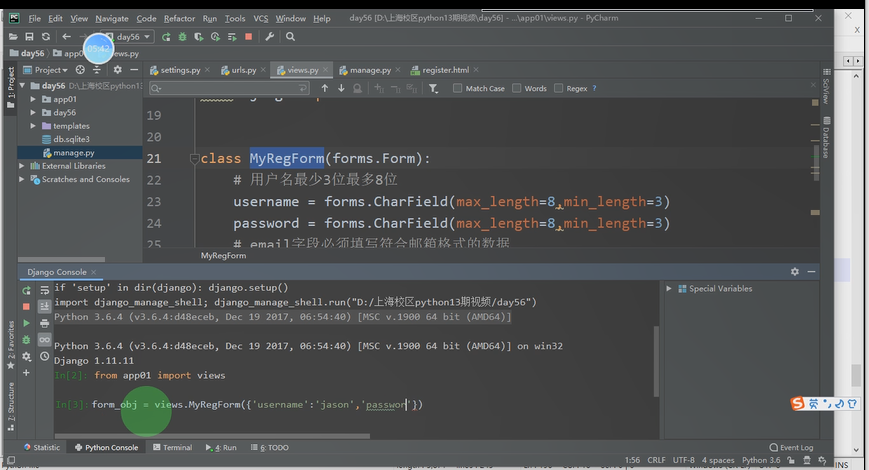
3.校验数据 console测试 is_valid() cleaned_data errors 返回的数据都是字典格式
如何校验数据 # 1.传入待校验的数据 用自己写的类 传入字典格式的待校验的数据 form_obj = views.MyRegForm({'username':'jason','password':'12','email':'123456'}) # 2.判断数据是否符合校验规则 form_obj.is_valid() # 该方法只有在所有的数据全部符合校验规则才会返回True False # 3.如何获取校验之后通过的数据 form_obj.cleaned_data {'username': 'jason'} # 4.如何获取校验失败及失败的原因 form_obj.errors { 'password': ['Ensure this value has at least 3 characters (it has 2).'], 'email': ['Enter a valid email address.'] } Out[16]: {}
4. 数据校验 注意点
注意 forms组件默认所有的字段都必须传值 也就意味着传少了是肯定不行的 而传多了则没有任何关系 只校验类里面写的字段 多传的直接忽略了
form_obj = views.MyRegForm({'username': 'jason', 'password': '123456'})
form_obj.is_valid()
Out[12]: False
form_obj.errors
Out[18]: {'email': ['This field is required.']}
form_obj = views.MyRegForm({'username': 'jason', 'password': '123456', "email": '123@qq.com', "hobby": 'hahahaha'})
form_obj.is_valid()
Out[14]: True
form_obj.cleaned_data
Out[15]: {'username': 'jason', 'password': '123456', 'email': '123@qq.com'}
form_obj.errors
5. forms渲染标签: form组件只能渲染input select
1.渲染标签
后端


前端
如何渲染页面 你需要先写一个类 forms组件只帮你渲染获取用户输入(输入 选择 下拉 文件)的标签 不渲染按钮和form表单标签 渲染出来的每一个input提示信息都是类中字段首字母大写 <p>第一种渲染方式:多个p标签 本地测试方便 封装程度太高了 不便于扩展</p> {{ form_obj.as_p }} {{ form_obj.as_ul }} {{ form_obj.as_table }} <p>第二种渲染方式: 扩展性较高 书写较为繁琐</p> <label for="{{ form_obj.username.id_for_label }}">{{ form_obj.username.label }}</label> {{ form_obj.username }} {{ form_obj.password.label }}{{ form_obj.password }} {{ form_obj.email.label }}{{ form_obj.email }} <p>第三种渲染方式 推荐使用</p> {% for form in form_obj %} <p> {{ form.label }}{{ form }}</p> {% endfor %}
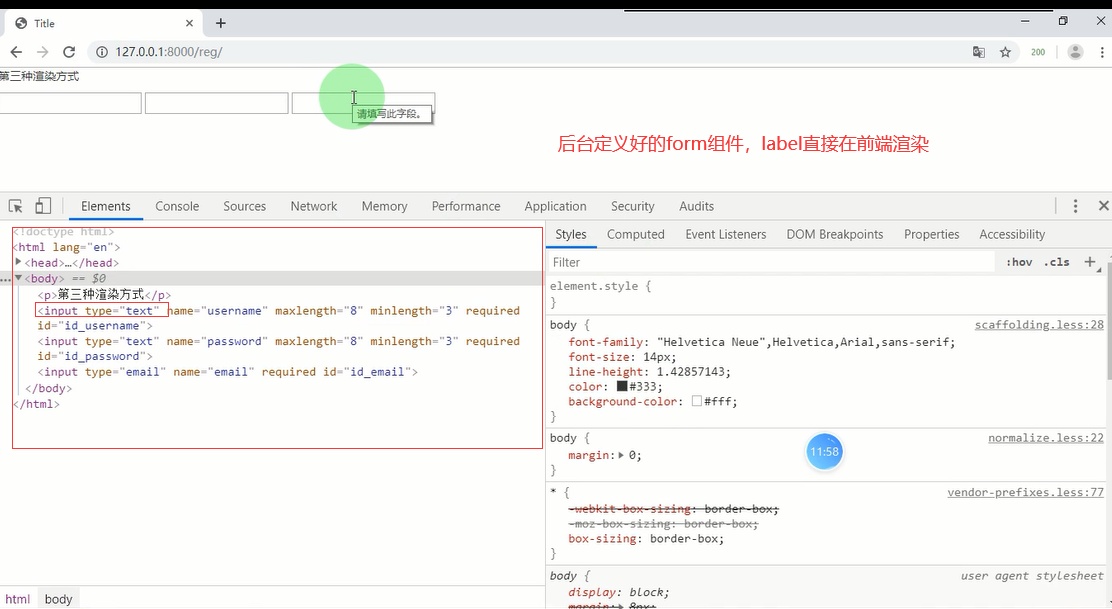
6 .forms组件的渲染+获取前端数据+后端校验+渲染错误信息+
补充:取消浏览器的自动校验功能 novalidate
<form action="" method="post" novalidate>
前端
如何渲染错误信息 前端 <form action="" method="post" novalidate> {% for form in form_obj %} <p> {{ form.label }}{{ form }} <span>{{ form.errors.0 }}</span> # 这个是模板语法 索引不会出现超出报错 </p> {% endfor %} <input type="submit"> </form>
后端: get请求 form_obj为空 先渲染form标签
然后post请求 form_obj接收前端数据 进行处理
后端 def reg(request): # 1 先生成一个空的类对象 form_obj = MyRegForm() if request.method == 'POST': # 3 获取用户数据并交给forms组件校验 request.POST form_obj = MyRegForm(request.POST) # 4 获取校验结果 if form_obj.is_valid(): return HttpResponse('数据没问题') else: # 5 获取校验失败的字段和提示信息 print(form_obj.errors) # 2 直接将该对象传给前端页面 return render(request,'reg.html',locals())
7.forms组件常用参数

1.常用参数
常用参数 label input的提示信息 error_messages 自定义报错的提示信息 required 设置字段是否允许为空 initial 设置默认值 widget 控制type类型及属性(可以使用bootstrap的样式) widget=forms.widgets.TextInput(attrs={'class':'form-control c1 c2'}) widget=forms.widgets.PasswordInput(attrs={'class':'form-control'})
后端写法
class MyRegForm(forms.Form): # 用户名最少3位最多8位 username = forms.CharField(max_length=8,min_length=3,label='用户名', error_messages={ 'max_length':"用户名最长8位", 'min_length':"用户名最短3位", 'required':"用户名不能为空" },required=False,initial='jason', widget=forms.widgets.TextInput(attrs={'class':'form-control c1 c2'}), ) password = forms.CharField(max_length=8,min_length=3,label='密码', # widget=forms.widgets.PasswordInput(attrs={'class':'form-control'}) ) confirm_password = forms.CharField(max_length=8,min_length=3,label='确认密码', # widget=forms.widgets.PasswordInput(attrs={'class':'form-control'}) )
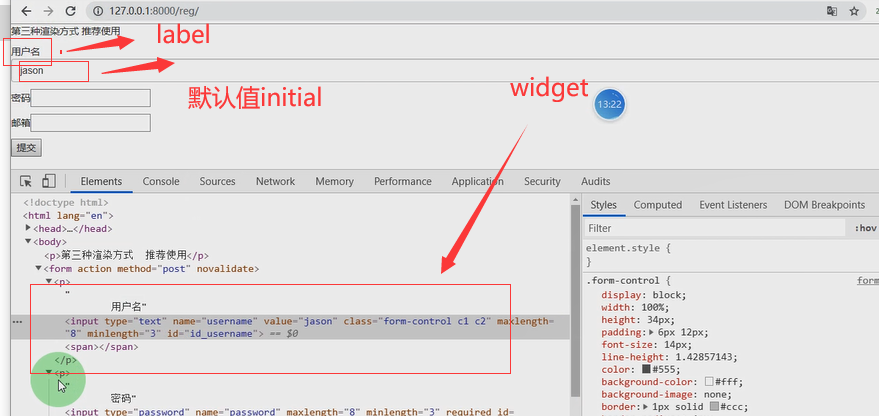
8.钩子函数
作用:用于forms组件的数据校验 记忆:把cleandata 勾出来校验 校验完成再放回去
钩子函数 全局钩子(针对多个字段) 校验密码与确认面是否一致 记忆:特例法: 局部钩子(针对单个字段) 校验用户名中不能包含666 # 全局钩子 def clean(self): # 校验密码和确认密码是否一致 password = self.cleaned_data.get('password') confirm_password = self.cleaned_data.get('confirm_password') if not password == confirm_password: # 展示提示信息 self.add_error('confirm_password','两次密码不一致') return self.cleaned_data # 局部钩子 def clean_username(self): username = self.cleaned_data.get('username') if '666' in username: self.add_error('username','光喊666是不行的') return username # 如果你想同时操作多个字段的数据你就用全局钩子 # 如果你想操作单个字段的数据 你就用局部钩子
后端代码
class MyRegForm(forms.Form): # 用户名最少3位最多8位 username = forms.CharField(max_length=8,min_length=3,label='用户名', error_messages={ 'max_length':"用户名最长8位", 'min_length':"用户名最短3位", 'required':"用户名不能为空" },required=False,initial='jason', widget=forms.widgets.TextInput(attrs={'class':'form-control c1 c2'}), ) password = forms.CharField(max_length=8,min_length=3,label='密码', # widget=forms.widgets.PasswordInput(attrs={'class':'form-control'}) ) confirm_password = forms.CharField(max_length=8,min_length=3,label='确认密码', # widget=forms.widgets.PasswordInput(attrs={'class':'form-control'}) ) # 全局钩子 def clean(self): # 校验密码和确认密码是否一致 password = self.cleaned_data.get('password') confirm_password = self.cleaned_data.get('confirm_password') if not password == confirm_password: # 展示提示信息 self.add_error('confirm_password','两次密码不一致') return self.cleaned_data # 局部钩子 def clean_username(self): username = self.cleaned_data.get('username') if '666' in username: self.add_error('username','光喊666是不行的') return username
9.正则校验(forms组件补充知识点)
正则校验 手机号开头校验
from django.core.Validators import RegexValidator phone = forms.CharField( validators=[ RegexValidator(r'^[0-9]+$', '请输入数字'), RegexValidator(r'^159[0-9]+$', '数字必须以159开头') ] ) 百度身份证正则
10.单选框 下拉框。。。 (不需要记,用的时候过来copy)
################了解知识点(指定去哪里拷贝即可)################ gender = forms.ChoiceField( choices=((1, "男"), (2, "女"), (3, "保密")), label="性别", initial=3, widget=forms.widgets.RadioSelect() ) hobby = forms.ChoiceField( choices=((1, "篮球"), (2, "足球"), (3, "双色球"),), label="爱好", initial=3, widget=forms.widgets.Select() ) hobby1 = forms.MultipleChoiceField( choices=((1, "篮球"), (2, "足球"), (3, "双色球"),), label="爱好", initial=[1, 3], widget=forms.widgets.SelectMultiple() ) keep = forms.ChoiceField( label="是否记住密码", initial="checked", widget=forms.widgets.CheckboxInput() ) hobby2 = forms.MultipleChoiceField( choices=((1, "篮球"), (2, "足球"), (3, "双色球"),), label="爱好", initial=[1, 3], widget=forms.widgets.CheckboxSelectMultiple() )
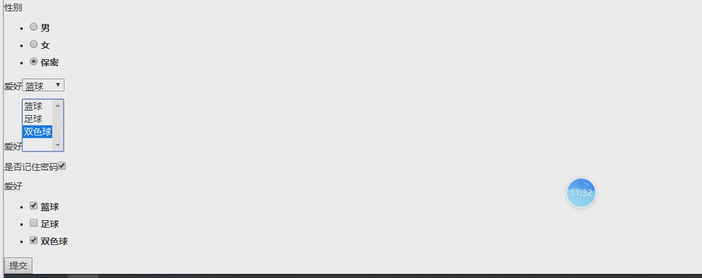
django操作cookies 和 sessions 只要是临时存储 都可以考虑cookies sessions
1.cookies 和 session 介绍
django操作cookie与session
cookie与session的作用
保存信息
当你第一次登陆成功之后 服务端给你返回了一个随机字符串
保存客户端浏览器上 之后再次朝服务端发请求 只需要携带该随机字符串
服务端就能够识别当前用户身份
超时时间的概念
cookie虽然是保存在客户端的浏览器上的 但是是服务端设置的
浏览器也是可以拒绝服务端对要求 不保存cookie
2.cookies使用
cookie是保存在浏览器上的键值对
1.设置cookies的步骤 :1. obj= render(....) 2. obj.set_cookies() request.COOKIES.get() obj.delete_cookie()
cookie 保存在客户端浏览器上的键值对 return HttpResponse('...') return render(...) return redirect(...) # 变形 obj = HttpResponse('...') return obj obj1 = render(...) return obj1 obj2 = redirect(...) 设置cookie obj.set_cookie() 获取cookie request.COOKIES.get() 删除cookie obj.delete_cookie()
print('request.path_info:',request.path_info) # 只拿路径部分 不拿参数
print('request.get_full_path():',request.get_full_path()) # 路径加参数
request.path_info: /home/
request.get_full_path(): /home/?username=jason&password=123
示例: 思路: 1.用户登录成功后,服务端给浏览器设置一个cookies
2. 其它功能函数获取浏览器cookies 如果有,说明用户已经登录可以访问该函数功能
3.使用登录装饰器

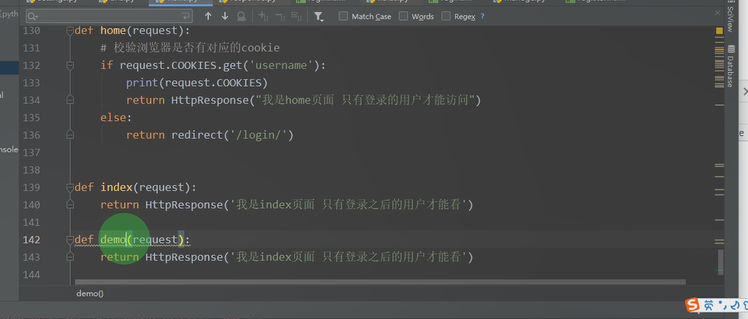
2.from functool import wraps 装饰器修复技术
@wraps(func)
装饰器中@wraps(func) 作用:
函数中的@wraps(func)又是做什么的呢?这里就涉及到了装饰器的一个小细节问题:被装饰后的函数本质上已经不是原来的函数了,
所以原函数的某些信息比如:__name__、__doc__等值就变了。而@wraps()的作用就是把原函数的相关信息代入到新的函数中。
3.基于cookies的登录装饰
from functools import wraps def login_auth(func): @wraps(func) def inner(request,*args,**kwargs): # 执行被装饰函数之前你可以做的事情 if request.COOKIES.get('username'): res = func(request,*args,**kwargs) return res else: return redirect('/login/) return inner def login(request): if request.method == 'POST': username = request.POST.get('username') password = request.POST.get('password') if username == 'jason' and password == '123': obj = redirect('/home/') # 设置cookie obj.set_cookie('username','jason666',max_age=3) return obj return render(request,'login.html') @login_auth def home(request): # 校验浏览器是否有对应的cookie # if request.COOKIES.get('username'): # print(request.COOKIES) # return HttpResponse("我是home页面 只有登录的用户才能访问") # else: # return redirect('/login/') return HttpResponse("我是home页面 只有登录的用户才能访问") @login_auth def index(request): return HttpResponse('我是index页面 只有登录之后的用户才能看')
4.新需求:用户没登陆先访问了index 页面 跳转到了登录页面 如何在用户登录之后再跳回index页面
'/index'--->走装饰器--->login()---->'/index'
这里结合了cookies 的设置,获取,删除
# 装饰器模板 from functools import wraps def login_auth(func): @wraps(func) def inner(request,*args,**kwargs): # print('request.path_info:',request.path_info) # print('request.get_full_path():',request.get_full_path()) # 执行被装饰函数之前你可以做的事情 target_url = request.path_info 第一步: 拿到url if request.COOKIES.get('username'): # 获取cookies res = func(request,*args,**kwargs) return res else: return redirect('/login/?next=%s'%target_url) 第二步:跳转到登录页面 提交后 把target_url当成参数传给login函数 return inner def login(request): if request.method == 'POST': username = request.POST.get('username') password = request.POST.get('password') if username == 'jason' and password == '123': # target_url = request.GET.get("next",'/home/') target_url = request.GET.get("next") 第三步:获取target_url # 判断用户登录之前是否有想要访问的url if target_url: # 保存用户登录状态 obj = redirect(target_url) 第四步: 重定向到目标url else: obj = redirect('/home/') # 设置cookie obj.set_cookie('username','jason666',max_age=3) # 设置cookies 有效时常3秒 return obj return render(request,'login.html')
注销 删除cookies
@login_auth def logout(request): obj = HttpResponse('注销了') obj.delete_cookie('username') return obj
3.session使用
保存在服务器上的键值对
session 保存在服务端上的键值对 设置 request.session['key'] = value """ 1.django内部会自动生成一个随机字符串 2.去django_session表中存储数据 键就是随机字符串 值是要保存的数据(中间件干的) 3.将生成好的随机字符串返回给客户端浏览器 浏览器保存键值对 sessionid 随机字符串 """ 获取 request.session.get('key') """ 1.django会自动取浏览器的cookie查找sessionid键值对 获取随机字符串 2.拿着该随机字符串取django_session表中比对数据 3.如果比对上了 就将随机字符串对应的数据获取出来并封装到request.session供用户调用 """ django中默认的session超时时间为14天 # 设置会话Session和Cookie的超时时间 request.session.set_expiry(value) * 如果value是个整数,session会在些秒数后失效。 * 如果value是个datatime或timedelta,session就会在这个时间后失效。 * 如果value是0,用户关闭浏览器session就会失效。 * 如果value是None,session会依赖全局session失效策略。 # 删除当前会话的所有Session数据 request.session.delete() # 删除当前的会话数据并删除会话的Cookie。 推荐使用 request.session.flush() 这用于确保前面的会话数据不可以再次被用户的浏览器访问 例如,django.contrib.auth.logout() 函数中就会调用它。 session是保存在服务端
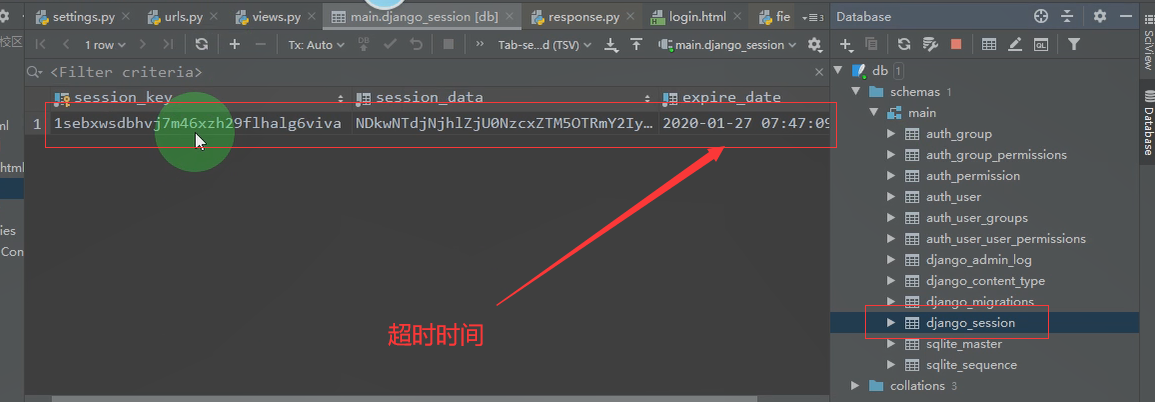
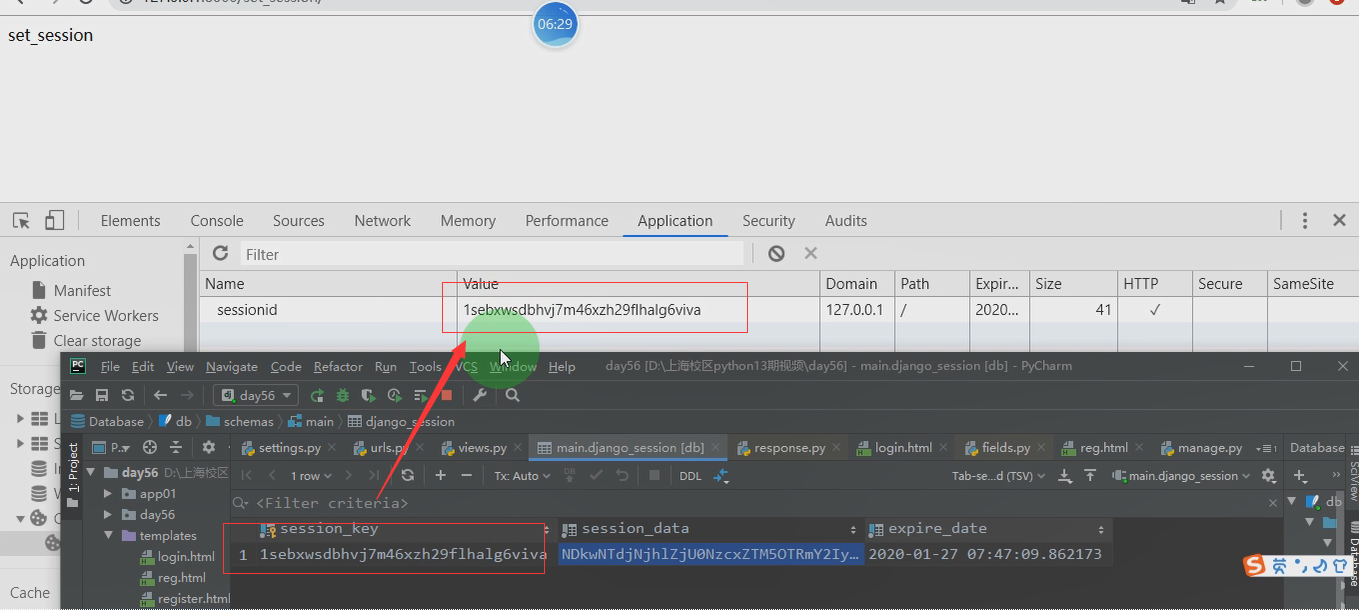
示例: request.session 设置
项目大体思路 登录设置session key会给到浏览器,request.session.get(key) 获取浏览器发过来的sessionkey 作对比
def set_session(request): # request.session['username'] = 'egondsb' request.session['name'] = 'egon' # request.session.set_expiry(5) return HttpResponse("set_session") from django.http import JsonResponse def get_session(request): # print(request.session) # <django.contrib.sessions.backends.db.SessionStore object at 0x00000259F72683C8> print(request.session.get('name')) return HttpResponse("get_session") def del_session(request): request.session.flush() return HttpResponse('注销了')



